.
Parts : 1 - 2 - 3 - 4 - 5 - 6 - 7 - 8 -
PAINTINGS
Very view Ancient Greek paintings survived and what we know is mainly from Roman copies sometimes probably of not the same quality as the originals. How much these paintings are close to the originals is unknown. Many paintings have been produced by artists who were paid to decorate the walls in houses and who sometimes used drawings of original masterpieces. We have important informations about Greek paintings and artists from Pliny the Elder, a Roman who was born in 24 or 25 AD and who died 24-August 79 AD from toxic gases as his body was found, one of the victims of the Vesuv explosion that destroyed Pompeii and killed all its citizens. Pliny the Elder: the Natural History (Latin Version) It took most of Pliny's time to collect the material reading other books in order to write “The Natural History”. The only time he took from his work was for his bath, and by bath I mean his actual immersion, for while he was being rubbed down and dried he had a book read to him or dictated notes. Pliny the Younger, Letters 3.5.14-16. Probably this also explains why Pliny was not married (http://www.livius.org/pi-pm/pliny/pliny_e3.html#history )
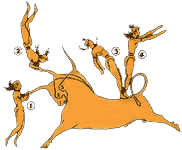
Images from a Sarcophagus ("Flesh-Eater") in Agia Triada
The Minoan Agia Triada Sarcophagus Fresco
Santorini: Wall Paintings and the 600 Megaton explosion that destroyed a Paradise
Minoan Painting
Mycenaean Painting
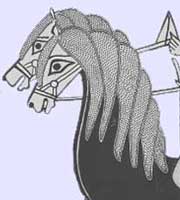

Archaic horse raider, with two horses (The horses reminds Japanese Manga ) from a Melian Amphora, Athens
The Francois Vase a major monument in Greek Pottery history, smashed by a Museum guard in 1900 in 638 pieces. The restored volute krater with many illustrations of various mythological stories (reminds me the illustrated man of Bradbury)
..but the emotional climax was the figure of Agamemnon himself, whose face was covered by a veil as he performed the sacrifice: as his emotions were not explicitly revealed, the viewer was left to imagine them in all their unbearable intensity. The picture thus succeeded in representing what it did not represent; in acknowledging the limits of art, it transcended them. Antiquity and the Middle Ages, Chapter 1
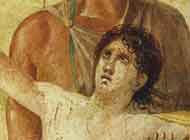
Polygnotus was a famous Greek painter. He produced various works, for example one in Delphi that decorated the so-called Cnidian Lesche of Delphi. He also produced drawings who decorated the famous "Painted" Stoa of Athens, the house of a famous philosophical school. A few centuries later Pausanias, the most famous tourist, of antiquity visited Delphi. Like today there were persons who explained to the visitors, including Pausanias, the complex drawings with mythological scenes from the Iliad and Odyssey. The descriptions of Pausanias are lengthy so that in principle we know the persons and their position of the two paintings that decorated the Lesche. It is of course impossible to describe a painting with words.


A reconstruction in the period 1892/1893 by C. Robert of the two paintings of Polygnotus from the Lesche of the Cnidians based on a description of Pausanias. Later reconstructions using archaeological information divide each painting into three separate paintings. One of those who tried to produce a reconstruction was Wolfgang Goethe. Aristoteles calls Polygnotus Ethographos describing that he tried to show the characters of the persons. One of many interesting stories is a person "Oknos" who produces a rope (the famous rope of Oknos) while a female donkey behind eats the rope. As Pausanias explains it was a known Greek who worked hard but his wife spent all the money he earned. The donkey thus symbolizes his wife who destroys his work.
A Lost Painting by Polygnotos at Delphi
Painting: 5th century BC , Painting: 4th century BC
The Mysterious Fayum Portraits
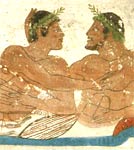
Diving into the underworld into a mens party, a symposium, spending the time with discussions, flirting, music and the kottabos game.
The Tomb Diver and the Symposium
The palace of Kadmos in Thebes
In the classical period Greek painters and sculptors were considered like workers. They were classified as banausoi, i.e. those who need to work for living. The situation was different for poets who were considered as artists. It is not surprising that there was a Muse for poetry or for astronomy but no Muse for painters or sculptors. It was Raphael who did not agree that painters and sculptors are not creative like poets. In the School of Athens he included himself as Apelles together with the gratests philosophers, astronomers and others scientists. But the situation was actually better for painters and sculptors in the Hellenistic period. The Kings payed a lot to obtain works of famous artists. While Polygnotus was proud to produce some paintings like that for the Stoa in Athens without obtaining money (he did it to honour the Polis) in the Hellenistic times many great artists obtained incredible sums for their work. Alexander took in his expedition historians and painters who were a kind of "embedded" propaganda journalists.
Ancient Greek Pottery Painters , Ancient Greek Pottery (some important pottery artists who lived and worked in Athens were probably non-Greeks )
The difference between Hellenistic sculpture and painting is surprising (from what we know from Roman copies) concerning the realism of objects . Sculptures represent optimal the three dimensional geometry. The perspective in the two dimensional paintings is not perfect because perspective in a two dimensional image is a much more complicated problem. More than 1500 years had to pass until Renaissance paintings such as the School of Athens included a true perspective.
MOSAICS
One of the earliest mosaics mentioned in literature are those made for the ship Syracusia of Hiero II. with scenes from the Iliad, which took 300 skilled workmen a whole year to execute (Athenaeus, 206 d).
Alexander and the Battle of Issus
The Doves on the Edge of a Bowl
Greek Mythology Mosaics from Zeugma, a Hellenistic (later Roman) city in today's Turkey, founded by a general of Alexander the Great (Seleucus I Nicator), (descriptions), (Zeugma in Greek means connection or bridge) Drowned Cities of the Upper Euphrates
The Street Musicians of Dioskourides
Greek Jewelery: 5000 years of tradition
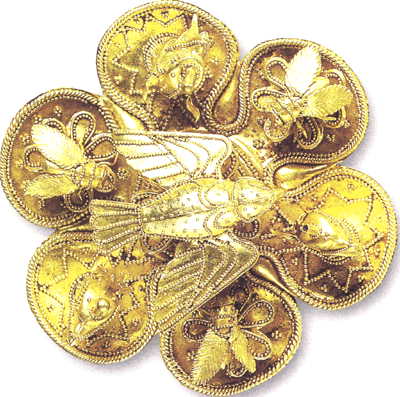
Rosette from a diadem, richly embellished with filigree decoration, 7th century BC. (Athens, National Archaeological Museum, XP.1177-1181).
TERRACOTTA STATUES
Tanagra figurines were produced mainly around 340-200 BC (not only in Tanagra but also in other places such as Athens). They were discovered around 1870. Women were mainly represented. Sculptors who produced small figurines of women were called coroplasts (from kore the girl and plastein to sculpt).
MASKS, ACTORS, THEATER related Arts
The "Agamemnon" Mask
JEWELS
6000 Years of Tradition. The Hellenic Jewellery (Hellenic Ministry of Culture)
Antique Jewellery Art in the The State Hermitage Museum, St. Petersburg, Russia
Miscellanous
Ancient Greek Arts: The Golden Section and the Golden Rectangle
Influence of Greek Art
Evolution of the Buddha Image , Vajrapani the protector of Buddha as Hercules , More Info about Greco-Buddhism
According to Wikipedia the Zeus Temple in Cyrene was intentionally damaged under orders of Moammar Al Qadhafi in the summer of 1978
The Destruction of Ancient Greek Art
European Art related to ancient Greece, Influence of Greek Art
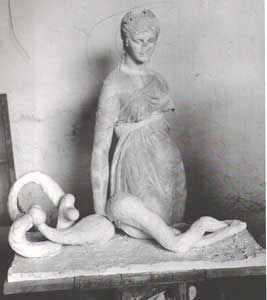
A Greek sculpture “thinking” about a reclining nude of Pablo Picasso who said : "The Parthenon is really only a farmyard over which someone put a roof; colonades and sculptures were added because there were people in Athens who happened to be working and wanted to express themselves. It is not what the artist does that counts, but what he is. "
The Impact of Hellenism On Rome
Greek Mythology together with stories of the Bible were an an important subject of Renaissance art. Even centuries later Art was inspired by Greek/Roman mythology.
Raphael: The School of Athens, Who is Who in Science and the Arts?
Raphael : The Parnassus (Who is Who in Literature?)
The Louvre Apollo Gallery dedicated to the glory of Louis XIV, the Sun King
Ingres: The Apotheosis of Homer, Who is Who in Literature and the Arts?
Rodin Sculptures:
- The Centaur Woman (Paris, Rodin Museum, 1887), Eos and Tithonus (Washington, National Gallery of Art, 1905) ,
- Orpheus and Eurydice (New York, The Metropolitan Museum of Art, 1893) , The Danaid (Paris, Rodin Museum, 1889)
- Eros and Psyche ( Hermitage, 1905)
| Ancient Greece
Science, Technology , Medicine , Warfare, , Biographies , Life , Cities/Places/Maps , Arts , Literature , Philosophy ,Olympics, Mythology , History , Images Medieval Greece / Byzantine Empire Science, Technology, Arts, , Warfare , Literature, Biographies, Icons, History Modern Greece Cities, Islands, Regions, Fauna/Flora ,Biographies , History , Warfare, Science/Technology, Literature, Music , Arts , Film/Actors , Sport , Fashion --- |

